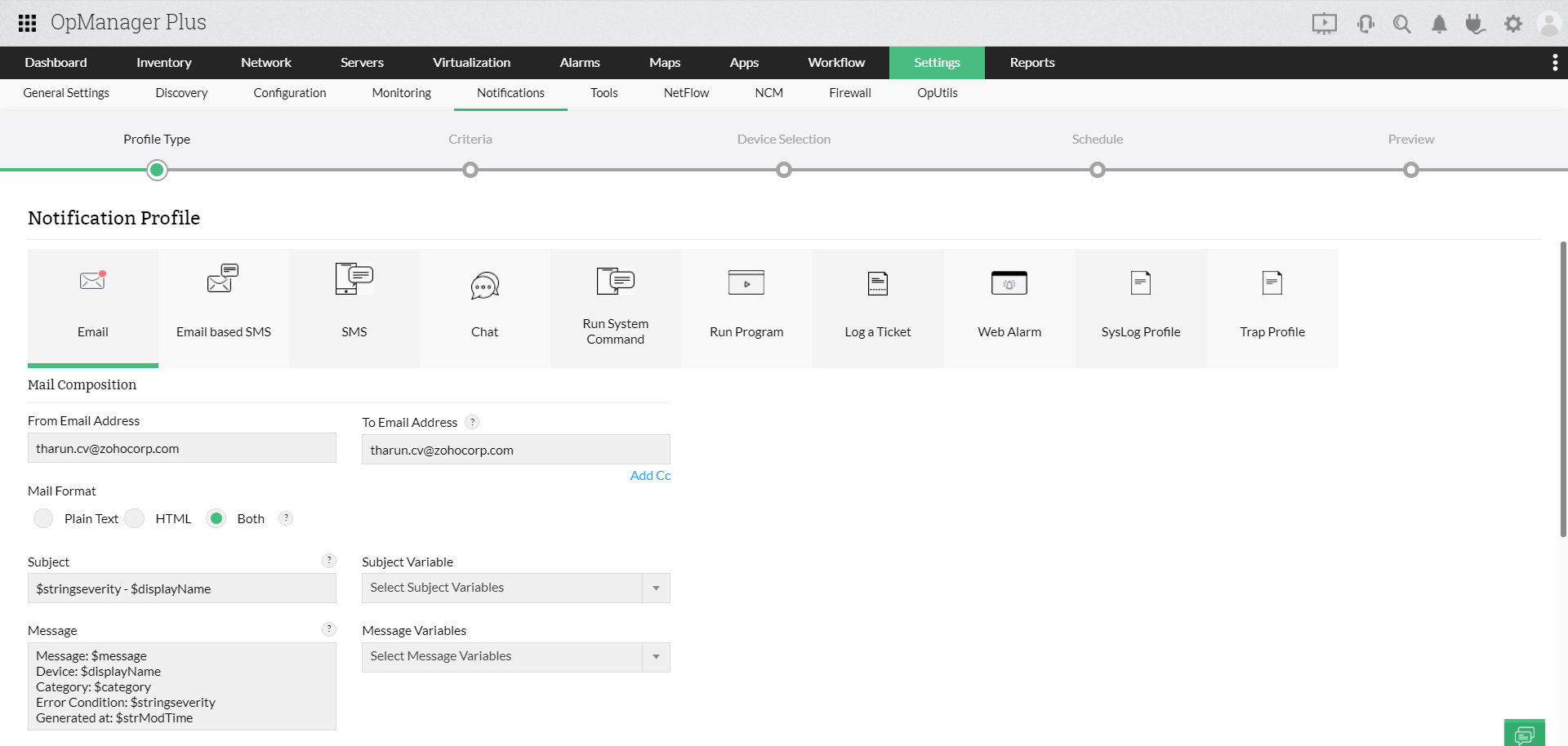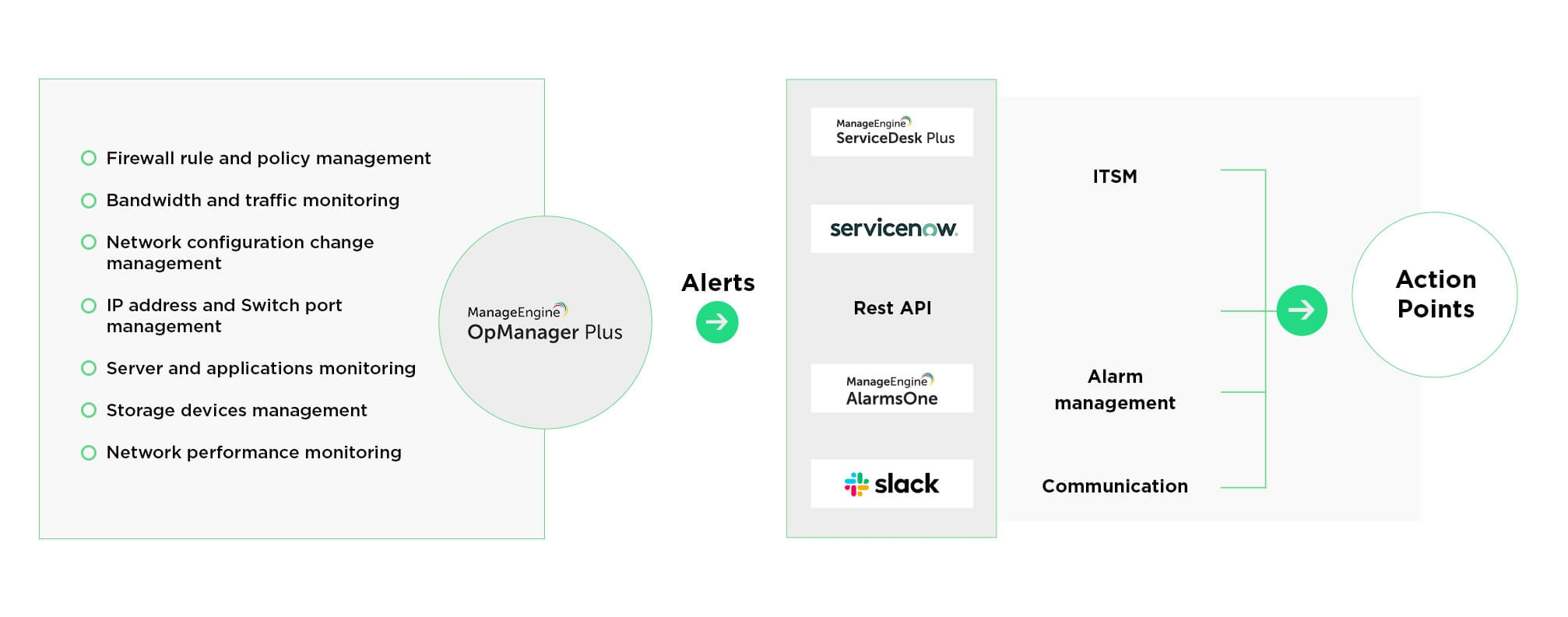Unified IT operations management
Unified IT operations management is a well-defined process aimed at helping IT admins get the most out of their IT infrastructure. Some of the key components of the IT operations management process are:
- Network monitoring
- Firewall analysis
- Configuration management
- Bandwidth and traffic management
- IP address and switch port management
- Application monitoring
- Storage monitoring
While each process of IT operations management has separate tools available in the market that can be used to ensure their efficient implementation, there is a growing need among IT admins to implement a unified network management approach to IT operations, primarily due to the following challenges an IT admin faces while using separate tools for each of these processes.
1. Toggling between multiple applications
IT operations management is not a single process. It is a combination of multiple processes. This means, in order to implement end-to-end IT infrastructure management, an IT admin has to constantly switch between the various tools used for each of these processes.
While this process provides the IT admin the required perspective into the functioning of the IT infrastructure, it prevents them from seeing the larger picture. It also requires extra effort and time, and occasionally results in IT admins missing out on key updates on one tool while focusing on the other.
2. Ensuring consistent updates in the network
When an update is performed in a device, the IT admin has to ensure that this update is reflected across multiple IT operation management tools. This process raises two important challenges:
- The problem of manual effort: IT admins have to manually update information in each and every tool that is involved in IT operations management. This activity is not scalable if changes are made across multiple devices.
- The problem of change inconsistency: Since the efficiency of IT operations management relies on the IT admins capability to consolidate the data from multiple tools and arrive at the bigger picture, if changes are inconsistent across multiple tools, the monitoring/management information provided by the various tools will also be inconsistent.
This will create inconsistencies in the IT operations management process cycle and render the organization incapable of getting the best results out of its IT operations management process.
3. Gaining the right amount of visibility
The visibility admins gain when using different IT operations management tools is moderate at best. Gathering the data and insights provided by various IT operations management tools to gain a deeper visibility into the overall efficiency of the IT infrastructure is a tedious and challenging process.
4. Setting up and managing alerts and notifications
The primary goal of an IT operations management process is to identify faults so that the IT admins can fix them before they cause business losses. This is done primarily by triggering alerts and notifications whenever something goes wrong.
The problem with having multiple tools for various IT operations management processes is that each of these tools has its own notification structure and technology.
This leads to:
- Manually adding notification profiles in each tool. The IT admin has to manually create notifications for devices/use cases in each of the tools. This requires manual effort and management.
- Maintaining an inventory of notification profiles. The notification profiles created for scenarios/devices have to be consistent. The IT admin also has to maintain a separate inventory of the notification configurations in order to be able to efficiently assess the problem that has occurred in the IT infrastructure.
5. Handling complex fault management challenges
Not managing your notification profiles leads to ineffective fault management. With different tools having different notification profiles, the IT admin is tasked with the challenge of correlating the notifications from various tools, finding the impacted devices, going back to the necessary tools, and carrying out the required fault management operations.
Example: Assume a server goes down and it has to be brought back up online by restoring the backup. For this, the admin needs to implement a configuration and restore the servers directly.
Normally, the IT admin gets a "server down" notification from the network management tool, goes to the configuration management tool, and pushes the backup server configuration details to revert the server settings. After all this, the server finally gets restored.
6. Tackling multi-licensing complexities
One important aspect of working with the various tools in implementing the IT operations management process is managing the licenses of the various tools involved.
The problem with having multiple tools for IT operations management is that:
- IT admins have to track the licensing details for each of the tools individually. This again brings in the problem of consistency, as IT admins have to ensure that all the essential devices, monitors, and parameters are licensed to each of the required tools.
Failing to ensure this will result in some essential devices not being monitored/managed by a tool due to non-availability of a license. This can disrupt the visibility the IT admin has on the particular device/monitor. - If each of these tools has different licensing models, to maintain an inventory and track each of the licenses separately can be a huge hassle. Of course, organizations always have the option of investing in a license management tool, but that will only increase costs for IT operations management.
7. Dealing with heterogeneous integration capabilities of various tools
The goal of a carefully crafted IT operations management strategy is to combine key insights from the individual processes (network monitoring, application monitoring, firewall analysis, bandwidth management, etc.) to arrive at a holistic view of the IT infrastructure performance. This will help IT admins isolate and troubleshoot faults and get the most out of every penny invested in their IT infrastructure.
To accomplish this, integration is a key aspect. Integration in itself can be classified into two sections:
- Intra-functional integration: Integrating with IT operational management components such as network monitoring, firewall analysis, configuration management, bandwidth and traffic management, IP address and switch port management, network management, application monitoring, and storage management.
- External integration: Integrating with other ITSM, communication, and other external tools such as ServiceNow, Slack, AlarmsOne, etc. to convert the monitoring data obtained from the IT operations management tool into actionable items and resolve IT faults.
When using multiple tools for IT operations management, each tool might have its own set of intra/external integrations. The concept of intra-integration between various processes gets thrown out of the window in most cases, except when multiple tools are purchased from the same vendor.
Having different external integrations is also problematic. For example, the network management and configuration management tool might be integrated to two different ITSM tools. This makes fault management difficult and results in service tickets being split accordingly, causing chaos for the support engineers. It also requires organizations to invest in extra tools to help advanced fault management ops.
OpManager Plus: Unified IT operations management and beyond
OpManager Plus is a unified IT operations management solution that brings all your operations management under a single roof.
Gain a holistic view of the entire IT infrastructure with dashboards and NOC views
OpManager Plus, a holistic IT operations management tool, brings all IT operations processes into a single console. This means IT admins can embed critical widgets and graphs from various processes, including network management, configuration management, switch port management, etc., into a single console.
With NOC views, the visibility into the entire network operations management process only gets more in-depth. IT admins not only gain the complete picture from one screen, but can also witness it being updated in real time.

Cross-functional IT fault management operations with Workflow
With OpManager Plus' Workflow feature, you can perform basic fault management activities at an IT operations management level. Workflow's advanced capabilities enable you to execute fault management operations at both network performance management and configuration management levels from a single Workflow diagram.

Central alerts and notifications
OpManager Plus allows IT admins to configure notification profiles universally across all IT operations management processes. This unified IT operations management tool helps you to ensure that when multiple alert messages pop up, each is managed adequately.
A single notification profile can be used in multiple instances. When you receive multiple notifications for a particular problem from multiple tools, keeping track of which notification is for which device can be chaotic. However, with notification profiles, this can all be avoided.

Unified licensing model
Unlike most vendors, OpManager Plus, a unified network management tool follows a single license model for multiple IT operations management processes. This unified model eliminates the need to purchase individual licenses for your IT operations management processes and the hassle of keeping track of various licensing models for the various processes/tools.
Integrating with external tools
OpManager Plus offers unified infrastructure monitoring by taking IT operations management beyond just detection and isolation of faults. From a single console, it allows alerts from various IT operations management processes to be converted into actionable items via integration with various external tools including ITSM tools, alarms management tools, communication tools, etc.
This unified ITOM-ITSM integration allows the alerts to be converted into actionable items and helps IT admins take action to resolve the identified faults much more proactively, saving physical and mental effort as well as money.

Try our 30 day free trial and learn how implementing a unified IT operations monitoring and management solution like OpManager Plus will increase your network monitoring efficiency. Or request a personalized demo custom catered to your requirements and understand how implementing a unified ITOM solution will benefit you.
